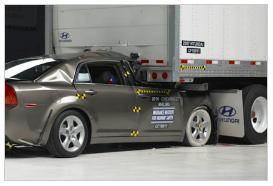|
Digital News Report – Traffic safety experts say that fewer Americans are dying from traffic accidents. In 2010 the number of traffic deaths dropped three percent and over the last five years (since 2005) that number has dropped 25 percent.
That is the lowest number of fatalities in over sixty years. The number of deaths is decreasing even with more people are driving more miles. “The decrease in fatalities for 2010 occurred despite an estimated increase of nearly 21 billion miles in national vehicle miles traveled,” the U.S. Department of Transportation (DOT) said in a statement.
Cars and highways are both safer. Also, over the past five years there has also been a crackdown on drunk driving.
Safer Cars
In 1949 there were no airbags, seatbelts and there was very little safety testing. Cars were heavy with few safety features.
Side impact safety has improved. It is estimated that the side airbags will save over 800,000 lives a year. Most new cars have this side protection.
Electronic stability control has helped keep cars from rolling. If the driver turns too-sharply the car can easily spin out of control. This feature is estimated to save 5,000 lives a year.
“NHTSA has also encouraged the development and use of technologies to prevent crashes, such as electronic stability control, forward collision warning and lane departure warning systems,” the DOT said.
Here are some of the safer cars. The Honda minivan and 3 large GM SUV models earned 2011 Top Safety Pick awards from the Insurance Institute for Highway Safety (IIHS). The Mazda 3, Volvo S60, and the Mini Cooper Countryman have all won awards last month.
The IIHS is also pushing for stronger underride guards on big rigs. These are the plates that fit under the tail-end of trailers to prevent cars from skirting underneath the back-end of trucks. “Rear guards are the main countermeasure for reducing underride deaths and injuries when a passenger vehicle crashes into the back of a tractor-trailer,” they said in a statement.
Safer Drivers
Seatbelts are saving lives too. In 1980 only 11 percent of drivers buckled up. In 1990 that figure was 50 percent, and today the number is 84 percent.
The DOT will likely focus on distracted drivers next. People talking on cell phones or texting will likely be the next targets for new legislation and enforcement.
By Mark Williams
Photo: SEVERE UNDERRIDE CRASH IIHS

